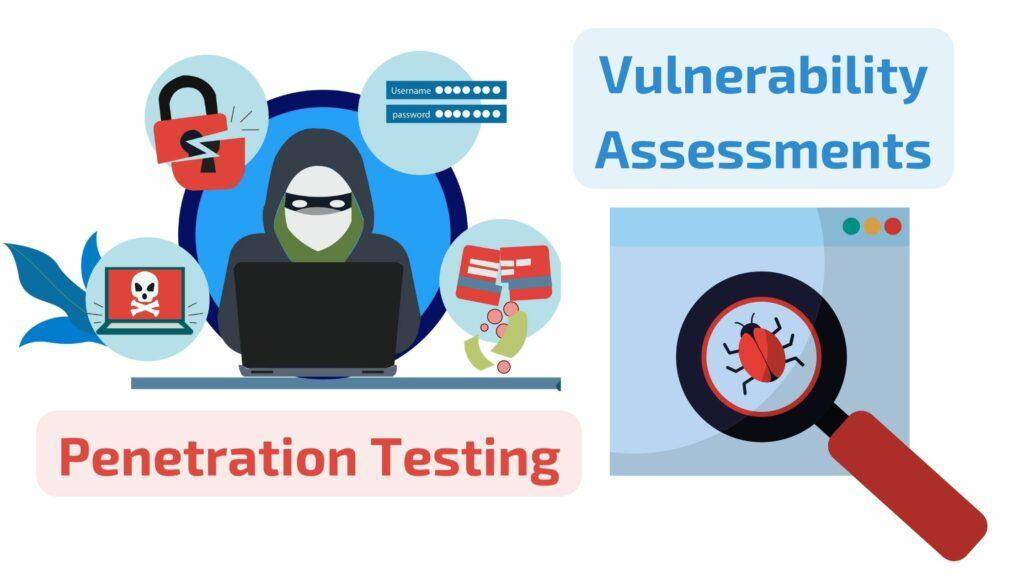Penetration testing is a method to detect vulnerabilities in IT systems and networks. This is an ongoing process; some of the Organizations do penetration testing on an annual basis and others do it more frequently. Penetration testing helps you understand where your Organization’s weaknesses lie and how they can be fixed.
Table of Contents
ToggleWhat is Penetration Testing?
Penetration testing is a way to test the vulnerabilities of a network, system or application. Penetration testing is also known as ethical hacking and it involves finding ways to break into your systems without actually breaking into them.
A penetration test is an authorized simulated attack on a computer system by a group of experts who seek out weak points in order to find out how they can be exploited. The purpose of this type of security assessment is usually to prove that the Organization’s defenses are strong enough or they can be made stronger through changes made by IT professionals based off of what was discovered during the test.
The first step in any penetration test is understanding what exactly you want to accomplish with it: whether that involves proving that your defenses are strong enough (or not), measuring risks associated with specific actions or events occurring within an Organization like theft or loss of data due after leaving laptops unattended at airports, etc., then deciding whether this particular kind of assessment will help achieve those goals most effectively given available resources/time constraints/etc..
Before a penetration test is started, it is extremely important to document the scope of the tests. This is to ensure that the tests are performed in a manner which will not exceed the agreed upon scope. It is also very important to ensure that the Penetration Tester understands what the goals of a particular penetration test are, as well as any constraints on time and resources available during this exercise.
Types of Penetration testing
Penetration testing can be done in different ways and for different reasons:
- Black box testing: This type of penetration testing is conducted without any prior knowledge about the system. The tester has no idea where the vulnerabilities are, so they start from scratch, looking for all possible points of entry into the system. This method is used to find flaws that have not been discovered yet or when developing a new product or service and you want to be sure there are no security issues with it.
- White box testing: A white box test can only be performed after an Organization has analyzed its own software code and found potential vulnerabilities. In this case, all security issues are known before starting the process of penetration testing which will allow testers to focus on specific areas rather than trying to find them blindly as with black box testing methods. There are several tools available that automate some parts of white box tests such as fuzzing (also called fault-injection). However these tools should never replace human expertise since they lack some important characteristics like creativity & intelligence which cannot be easily replicated by computers yet at least not on par with humans!
- Grey Box Testing: Grey box testing is a combination of both black-box and white box testing methods. Testers are given some information about the system, but not all of it. They may be provided with documentation or other sources that provide insight into how the application works, but they will still have to perform tests using whatever tools they have available.
What is Black Box Testing?
Black box testing is a technique that attempts to determine the security of a system or network based on how vulnerable it would be to an attacker who had no prior knowledge of the inner workings of that system. A black box test is also known as a functional test, and it tests whether or not a system can be compromised from an outsider’s point of view. In other words, you wouldn’t know how your bank’s website works or what its internal structure looks like—you’d just try to find ways to hack into it from the perspective of someone who didn’t have any prior knowledge about how banks work in general.
Let’s see some examples of Black Box Testing:
- You want to test the security of a new website that you’re developing. In this case, you’d want to perform black box testing because you want to know how vulnerable your system is from the perspective of an outsider who has no prior knowledge of how it works.
- You want to test whether or not your computer can be hacked by someone who doesn’t have any prior knowledge about its inner workings.
What is White Box testing?
White box testing, also called clear box testing, glass box testing or transparent box testing, is a software test design method in which the internal structure or source code of the item being tested is known to the tester. White box techniques emphasize the design or logic flow of program units, rather than their functionality. The name “white-box” comes from an analogy with white-box cryptography: where one knows what ciphers are used (the external inputs), but does not know how they are implemented (the internal workings).
In general terms it is any method that employs knowledge about the software’s implementation to derive test cases. This can be done by examining code or by examining documentation produced during development; in either case such information should include at least one version of its source code.
Let’s look at an example of White Box testing:
You know that the application uses a database, and you have access to its schema. In this case you can write tests based on how data is stored in the database. For example, if there is a table named “user” that stores user account information, then you could test functions related to creating new accounts or updating existing ones by using real data from the table (or at least by simulating it).
What is Grey Box Testing?
Grey Box testing is a type of Penetration testing where the tester has some information about the target. This is also known as Partial Knowledge Testing, knowledge based testing or hybrid testing. It is often used in conjunction with black box testing. Grey Box testing can be beneficial because it allows the tester to use their knowledge of the application’s architecture and behavior to find additional vulnerabilities that would not be found during Black Box testing. Grey Box testing is often used when an Organization has a limited amount of time or resources to perform penetration tests.
Here is an example of a Grey Box Penetration Test:
The tester has a detailed understanding of the application’s architecture and behavior. They may have access to source code, design documents or configuration files. For example, if the target application is running on an Oracle database server, the tester knows that there are ways of accessing data in other user accounts such as SYSDBA accounts. This allows them to find additional vulnerabilities that would not be found during Black Box testing.
What tools are commonly used for performing Penetration Testing?
When performing a penetration test, you’ll need a variety of tools. These tools can be categorized into two main groups: vulnerability scanners and penetration testing tools. Vulnerability scanners are used to identify potential security issues by analyzing your system. They look for known vulnerabilities that have been published in security bulletins or news articles and then report them back to you as either an alert or remediation script.
Here’s a list of some popular open source tools that are used in pen testing:
- Nessus (vulnerability scanner)
- Metasploit (exploitation framework)
- Wireshark (packet sniffer)
- Nmap (port scanner)
- Burp Suite (web application security testing tool)
- Cuckoo Sandbox (malware analysis tool)
Kali Linux is a Linux distribution that comes with numerous security tools pre-installed which also includes the tools mentioned above. This makes it easy to perform different types of penetration testing. kali Linux is one of the most popular Linux distributions used to perform Penetration Tests and Vulnerability Assessments.
Penetration testing steps
There are five (5) main steps included in Penetration Testing. Let us look at what each step is:
- Information Gathering: The first step in any penetration test is to gather as much information about the target as possible. This can be done by performing a port scan, identifying any publicly-accessible hosts, or even using social engineering techniques.
- Scanning & Enumeration: Once you have identified the systems that are present on the target, it is time to begin scanning them. This will include performing port scans and vulnerability scans as well as enumerating any publicly-accessible hosts.
- Exploitation: The next step is to attempt to exploit any vulnerabilities that you have identified. This could mean exploiting a remote code execution vulnerability, installing malware on the target system, or even performing social engineering attacks.
- Post Exploitation (Privilege Escalation, etc): Once you have gained access to the target system, it’s time to look at expanding your access. This can include performing privilege escalation attacks, installing additional malware on the target system, or even using the host as a pivot point for further attacks against other systems.
- Reporting: The final step is to report on your findings. This could include writing up a detailed report on all of the steps that you took, including screenshots, as well as any documentation of your attacks and exploitation attempts.
How does Penetration Testing differ from Vulnerability Assessment?

Penetration testing is a more advanced form of Vulnerability Assessment, which is done by an Information Security professional. Vulnerability Assessment tools scan the target environment and report on its vulnerabilities. However, these scans are performed from outside the target environment in a safe manner where no damage can be caused to the systems or data. The objective of Penetration Testing differs from that of Vulnerability Assessment because it involves real-world attacks on the network infrastructure and systems within a controlled environment. It uses professional hackers who have knowledge about all security loopholes that could be exploited for gaining access to sensitive information or systems within an Organization’s environment and is used for the following purposes:
- To identify vulnerabilities in a system or network and provide remediation advice.
- To test the security of an environment by attempting to break into it.
- To test the strength of the security controls in place to ensure they meet industry standards and best practices.
- To provide a report on the findings that can be used as a benchmark for future testing, vulnerability assessments or audits.
Why Penetration testing is important for Organizations?
Penetration testing is an important part of the security audit process. It helps in identifying the vulnerabilities and security weaknesses of an Organization. Penetration testing can be used to identify the threats to an Organization’s network and infrastructure, data, end users, etc. These threats could include attacks from malicious employees or outside hackers trying to gain access to sensitive information stored on your Company’s computers.
It can help you identify vulnerabilities in your network infrastructure and applications, which can then be fixed before they are exploited by hackers. Thus, penetration testing helps you protect against cyber-attacks and ensure compliance with various regulations like PCI DSS or GDPR.
Neumetric Offers Vulnerability Assessments and Penetration Testing services which include Web Application VAPT, Mobile Application VAPT, Virtual Private Cloud [VPC] VAPT and many more! To know more about all VAPT Services visit our TechSec page.
FAQs:
What are the 5 stages of penetration testing?
The five (5) main stages of Penetration Testing are:
- Information Gathering
- Scanning and Enumeration
- Maintaining Access
- Covering Tracks and Traces
- Reporting
What tools are used for penetration testing?
The most commonly used tools to perform penetration testing include:
- Nmap
- Metasploit
- Wireshark
- Burp Suite
- Nessus
These tools are pre-packaged with Operating Systems like Kali Linux and parrot OS which is also the most popular Operating Systems used to perform Penetration Testing.
What are the benefits of penetration testing?
Penetration testing is a great way to test your system and network security. It helps eliminate vulnerabilities, which can result in system breaches. Penetration testing also provides you with an action plan to fix the issues found during the test. You will have a better understanding of your system security and what needs to be done to improve it. This can help you avoid expensive data breaches and protect against cyber attacks. Penetration testing is also a great way to train your IT team on how to fix problems found during the test.
What is the risk of penetration testing?
There is always a risk of penetration testing. If your system has not been tested before, you may not know what to expect during the test. Some penetration tests can take several days or even weeks, depending on the size and complexity of your network. You should also consider that penetration testing involves trying to break into a system—if there are no vulnerabilities, then no one will be able to break into it! If you are concerned about the potential risks of penetration testing, you should consider hiring a professional penetration tester who can help you determine the best course of action for your business.
How often should Penetration Testing be done?
It’s important to note that the frequency of penetration testing will depend on your industry and threat environment. In some cases, you may only need to perform a penetration test once or twice a year. However, if your business is in an industry with high risk or has recently experienced a breach, then you should consider performing penetration tests more frequently—perhaps even every month!





